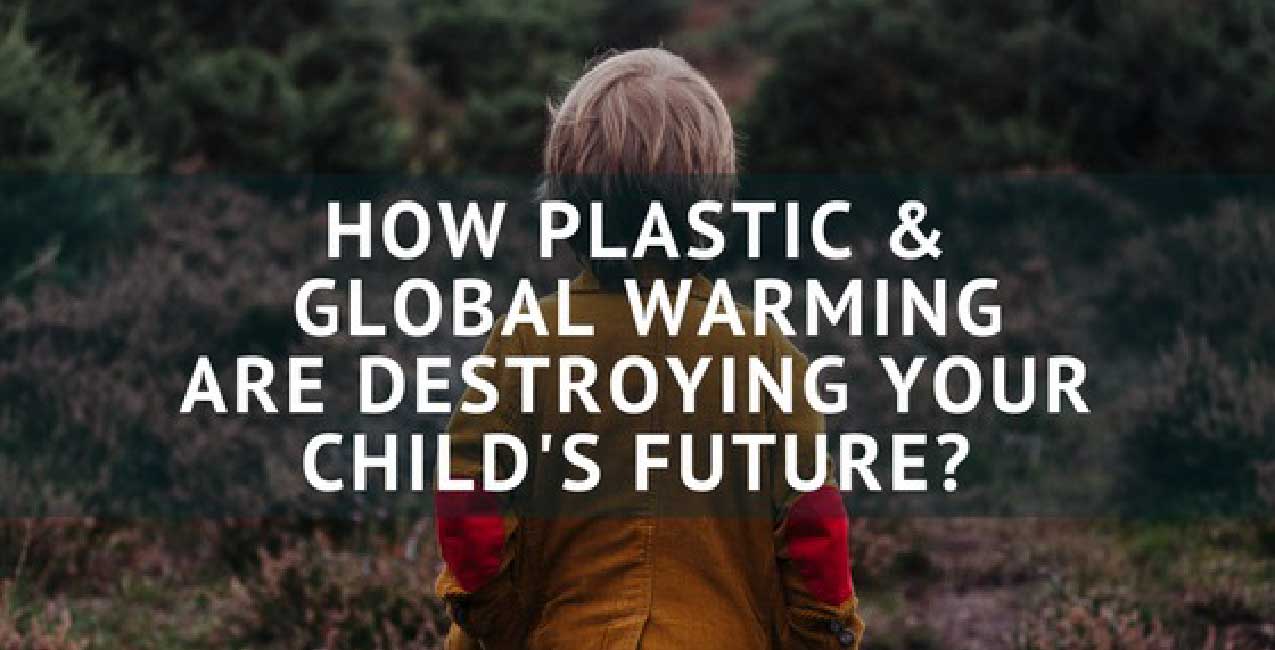- Empty cart.
- Continue Shopping
How plastic and global warming are destroying your child’s future

Climate change has been widely recognised as the biggest global health threat of the 21st century.
Along with the old and disadvantaged, children are particularly vulnerable to the negative effects of climate change. Children suffer around 90% of the disease burden from climate change.
UNICEF argues that, although children are more vulnerable to the effects of global warming, they have been largely left out of the debate. “We are hurtling towards a future where the gains being made for the world’s children are threatened and their health, wellbeing, livelihoods and survival are compromised … despite being the least responsible for the causes,” said David Bull, UNICEF’s UK executive director. “We need to listen to them.”
What can our children expect if we continue the way we’re going?
The impact climate change has on children born today may well be decided before they can vote on it.
Plastic, as common and unavoidable as it may seem, is a deadly material that is causing immense harm to our planet. Nearly 3.5 tonnes of plastic bags are discarded in a year and each plastic bag takes 1,000 years to degrade. This reduces the soil quality by a huge amount and will cause soil infertility in the future. Nearly 100,000 marine animals are killed each year due to plastic bags. Think of what kind of ocean your children will see?
The amount of harm plastic is causing to our environment is immense and as each of the natural resources on earth start losing quality, our children lose out on precious resources. Not just environment, even the health of humans is damaged with the consumption and use of plastic. With escalating rates of childhood illness these days, it is more important than ever to be careful about what you feed your child, from day one. Babies are already born at considerable risk due to the toxic load of their mothers. Some of this is from exposure to plastics and the contaminants present therein, such as BPA (Bisphenol A). The Centres for Disease Control and Prevention (CDC) has detected BPA in the urine of 95 percent of the 2517 people tested in the Fourth National Report on Human Exposure to Environmental Chemicals. This is a staggering number which suggests that plastic has already contaminated most of our generation, and this will only grow in the generations to come.
BPA, the compound found in plastic can have many adverse effects on the health of your child. Think about the amount of plastic compounds being consumed by your child when every food item, from flour to snacks is packed in plastic bags. Small children are constantly putting plastic toys in their mouth and even the production process of many consumables involves the addition of the material to the food. In 2009, the Environmental Working Group (EWG) found an average of 287 toxins, including BPA, mercury, fire retardants, and pesticides, in the umbilical cord blood of American infants.
Now, baby food manufacturers are compounding the problem by suggesting that busy moms feed their toddlers highly processed food sold in convenient plastic tubs. As if that isn’t enough, you microwave it first, further destroying and denaturing its nutritional value and promoting leaching of toxic chemicals right out of the plastic and into your baby’s meal.
Not just packaged boxes, but even packaged mineral water can harm your child’s body. It’s important to know that the plastic used for bottled water often contains BPA. BPA has been found to adversely affect foetuses, infants and children’s brains, and prostate glands. Behaviour disorders are also prevalent from BPA contamination leading to hyperactivity and aggression in children.
VC (aka: polyvinyl chloride or vinyl) is all around us. But, from both an environmental and health standpoint, PVC is the most toxic plastic. The manufacture and incineration of PVC also creates and releases dioxins, which cause a wide range of health effects including cancer, birth defects, diabetes, learning and developmental delays, endometriosis, and immune system abnormalities.
These chemicals and diseases are only few from the many dangerous ones that can affect children’s health. A widely available material like plastic is causing so much damage, think about the many materials that humans have created and released into the environment. These pollutants are destroying the entire world around us and climate change and global warming are serious issues which will lead to a complete breakdown, in the future, of the world, as we know it.







